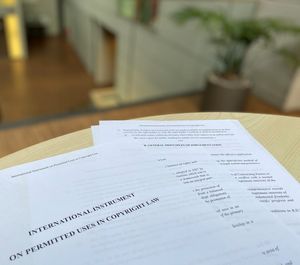With the aim of creating at international level a more balanced system regarding the scope of copyright protection, an academic initiative coordinated by the Max Planck Institute for Innovation and Competition developed the “International Instrument on Permitted Uses in Copyright Law” . This project, bringing together a group of 20 internationally renowned copyright specialists from different countries, was originated by some members of the expert group working on the “Declaration for a balanced Interpretation of the Three-Step Test in Copyright Law”, which was concluded in 2008. The Declaration advocates a more flexible application of the three-step test by means of interpretative guidelines in order to take account of legitimate user interests.
The Instrument goes one step further than the Declaration. Rather than stating mere recommendations, the Instrument includes concrete provisions to form an international treaty establishing a core of minimum permitted uses of works. By signing such a treaty, prospective Contracting Parties would be obliged to implement the minimum permitted uses in their national legislations.
With this “minimum permitted uses approach” the Instrument aims at counterbalancing the traditional “minimum protection approach” of international copyright legislation. The Instrument is meant to function as a lever for Contracting Parties to address the political pressure in international negotiations of bilateral or regional agreements in particular. Once in place, the Instrument will ideally facilitate cooperation amongst countries and help them to assert their common interests on a level playing field with countries trying to impose higher standards of protection in international negotiations. At the same time, implementing the Instrument in binding international legislation might foster a certain harmonization with regard to the limits of copyright protection.
The Instrument is composed of three parts. In Part A five groups of permitted uses are specified on the basis of the objectives pursued by each group of permitted uses: I. Freedom of expression and information; II. Social, political and cultural objectives; III. Use of software; IV. Uses with minimal significance; and V. Free circulation. Part B defines general principles aimed at guiding contracting parties in the implementation of permitted uses in their national legal orders. Contracting parties are obliged to implement effectively the permitted uses laid down in the Instrument but are free to determine the method of implementation: explicitly enumerating such permitted uses, creating general clauses or basing them on a fair use or fair dealing legislation are all matters for the national legal systems. Also, Contracting Parties are free to permit further uses of copyright-protected works, should their domestic needs require such national legislation. Part C deals with competition law as an external limit to copyright and is based on the modern understanding that competition law and copyright law are complementary legal fields, pursuing the objective of increasing the market offer of creative works.
You can find the International Instrument here:
International Instrument on Permitted Uses in Copyright Law
An article by Reto M. Hilty and Valentina Moscon about the International Instrument can be found in the recently published book The Cambridge Handbook of Copyright Limitations and Exceptions.
The current issue of IIC also dedicates its Editorial to the International Instrument.

